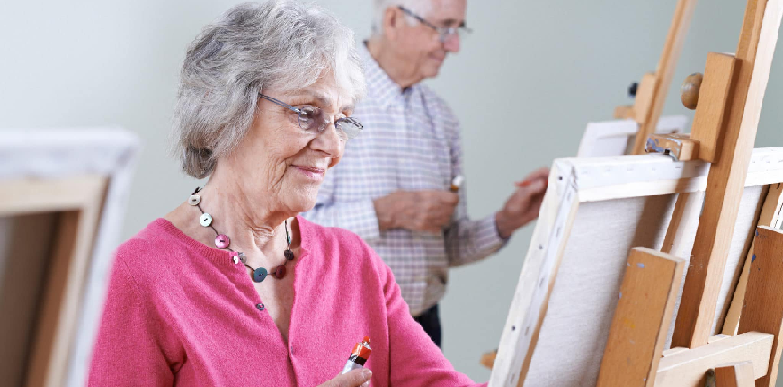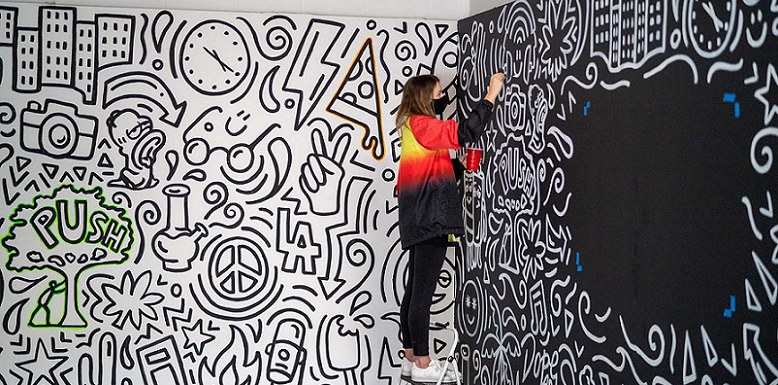Art has been a central aspect of human society for thousands of years, serving as a means of expression, cultural preservation, and social commentary. In recent times, the role of art in society has expanded to encompass its potential benefits for mental health. Studies have shown thaat participating in or simply enjoying the arts can have a profound impact on a person’s mental well-being, reducing stress, improving mood and cognitive functioning, and boosting self-esteem and confidence.
What Is Art?
Art can be described as a form of human expression that uses various mediums, such as paint, sound, or movement, to create a representation of ideas, emotions, or experiences. It can be both individual and collective, and can serve a range of purposes, including cultural preservation, social commentary, self-expression, and personal growth.
Art is a way for people to communicate, explore, and connect with their inner selves, as well as with each other and the world around them. It has the power to inspire, challenge, and evoke emotions, and can contribute to the development of a person’s identity, creativity, and sense of purpose. In essence, art is a fundamental aspect of human culture that has the ability to shape our perceptions, stimulate our imagination, and enrich our lives.
The Role of Art in Society
The role of art in society is multi-faceted and has evolved over time. In its simplest form, art serves as a means of expression and communication, allowing artists to convey their ideas, emotions, and experiences to a wider audience. Art can also play an important role in preserving cultural heritage, as well as serving as a tool for social and political commentary.
Art can have a significant economic impact, creating jobs and driving economic growth through the arts and cultural industries. Furthermore, art is often seen as a means of personal growth and education, offering opportunities for individuals to develop their creativity, self-expression, and sense of identity. Ultimately, the role of art in society is to provide a space for creative expression and reflection, to enrich our lives, and to foster a deeper understanding of the world around us.

Cultural Expression and Preservation of Heritage
Art plays a crucial role in the cultural expression and preservation of heritage. Through various forms of artistic expression, such as visual arts, performing arts, and literature, artists can capture and communicate the unique beliefs, values, and experiences of their cultures. In this way, art serves as a powerful tool for cultural preservation, preserving the stories, traditions, and customs of communities and passing them down from generation to generation.
For example, indigenous art has long served as a means of preserving the cultural heritage of indigenous peoples, providing a visual representation of their history, beliefs, and practices. Similarly, traditional dances, music, and theater performances offer a means of passing on cultural traditions, stories, and values.
Art also serves as a means of cultural expression, allowing communities to celebrate their cultural identity and share their experiences with the wider world. Through exhibitions, performances, and other cultural events, artists can showcase the unique aspects of their cultures and contribute to a greater understanding and appreciation of cultural diversity.
Social and Political Commentary
Art has a long history of serving as a powerful tool for social and political commentary. Through various forms of artistic expression, artists can raise awareness about societal issues and inspire change by offering new perspectives, challenging prevailing attitudes and beliefs, and creating thought-provoking works that encourage reflection and action.
For example, political cartoons and satirical artworks have been used for centuries to comment on political events and social issues, and can often be more effective in communicating a message than written or spoken words alone. Similarly, protest art and performance art have been used to draw attention to a range of social and political issues, from civil rights and equality to environmental activism and war.
In this way, art serves as a means of giving a voice to the voiceless and shining a light on issues that may otherwise go unnoticed or be ignored. Through artistic expression, artists can bring attention to important social and political issues, engage the public in discussions, and ultimately contribute to positive change in society.
Economic Impact
The role of art in society as it pertains to economic impact is significant and wide-ranging. The arts and cultural industries can create jobs and drive economic growth in a number of ways, from the direct employment of artists, performers, and support staff, to the indirect benefits of increased tourism, consumer spending, and tax revenue.
For example, the film and television industry, which is largely based on the creation and production of visual and performing arts, is a major contributor to the global economy, generating billions of dollars in revenue and providing employment opportunities for thousands of people. Similarly, the music industry, which encompasses a range of musical styles and genres, generates billions of dollars in revenue and provides jobs for musicians, composers, and other industry professionals.
In addition, the arts and cultural industries also play a key role in the development of creative industries, such as fashion, design, and advertising, which in turn contribute to economic growth and job creation. Furthermore, the arts and cultural industries can stimulate local economies by attracting tourists and encouraging consumer spending on cultural events, performances, and attractions.

Education and Personal Growth
The role of art in society as it pertains to education and personal growth is profound and multifaceted. Art provides a means of personal expression and can be a powerful tool for self-discovery and personal growth. Furthermore, through the process of creating and appreciating art, individuals can develop their creativity, critical thinking, and problem-solving skills.
For example, participating in art education programs, such as visual arts classes or music lessons, can help individuals to develop their artistic abilities and self-expression, while also fostering a sense of personal accomplishment and self-esteem. Similarly, exposure to various forms of art, such as literature, film, theater, and music, can broaden one’s cultural horizons, enrich their understanding of the world, and provide new perspectives and insights.
Art can also play a key role in education by providing a means of exploring complex ideas and issues. For example, art can be used to teach history, science, and other subjects in a more engaging and accessible way, and can provide a platform for exploring social and political issues in a safe and inclusive environment.
Benefits of Art for Mental Health
The benefits of art for mental health are numerous and well-documented. Art can be a powerful tool for reducing stress, improving mood, and promoting overall well-being. For example, participating in creative activities, such as painting, drawing, or playing a musical instrument, can provide a sense of accomplishment and help to relieve stress and anxiety. The process of creating art can also be a form of self-expression, allowing individuals to communicate their feelings and thoughts in a healthy and non-verbal way.
Therapeutic Effects
The benefits of art for mental health as it pertains to therapeutic effects are substantial and widely recognized. Art therapy, which involves the use of creative expression to promote emotional and psychological well-being, has been found to be an effective treatment for a range of mental health conditions, including depression, anxiety, and trauma.
For example, art therapy can provide a safe and non-threatening environment for individuals to explore and express their feelings and thoughts, even those that are difficult to put into words. Through the process of creating art, individuals can gain insights into their emotions, develop a better understanding of themselves, and learn new coping strategies for managing stress and anxiety.
Art therapy can also help to reduce symptoms of depression and anxiety, while also improving mood and emotional regulation. Research has shown that engaging in creative activities, such as painting, drawing, or playing a musical instrument, can increase feelings of joy, happiness, and well-being, while also reducing symptoms of depression and anxiety.
Art therapy can also be a valuable tool for individuals recovering from trauma, providing a means of processing and overcoming traumatic experiences in a supportive and non-threatening environment. Through art therapy, individuals can develop new perspectives on their experiences and gain a deeper understanding of the impact of trauma on their lives.

Stress Reduction
The benefits of art for mental health as it pertains to stress reduction are well-established and widely recognized. Engaging in creative activities, such as painting, drawing, or playing a musical instrument, can provide a powerful and effective way to manage stress and improve overall well-being.
For example, participating in creative activities can serve as a form of mindfulness, helping individuals to stay present in the moment and focus on the task at hand, rather than dwelling on stressors or worries. This can provide a much-needed break from the demands of daily life and help to reduce stress and anxiety.
The process of creating art can also be a form of self-expression, allowing individuals to communicate their feelings and thoughts in a healthy and non-verbal way. This can help to reduce stress and provide a sense of relief and release, allowing individuals to manage stress in a constructive and positive way.
The exposure to beauty and aesthetic experiences can also play a role in reducing stress and improving mood. Research has shown that exposure to art and nature can increase feelings of joy, happiness, and well-being, while also reducing symptoms of depression and anxiety.
Improved Mood and Cognitive Functioning
The benefits of art for mental health as it pertains to improved mood and cognitive functioning are significant and well-documented. Engaging in creative activities, such as painting, drawing, or playing a musical instrument, can provide numerous benefits for our mental health, including improved mood and cognitive functioning.
For example, participating in creative activities can increase feelings of happiness and well-being, while also reducing symptoms of depression and anxiety. Research has shown that exposure to beauty and aesthetic experiences can increase positive emotions and improve mood, providing a powerful tool for supporting our mental health.
Engaging in creative activities can also have a positive impact on cognitive functioning, including increased attention, concentration, and problem-solving skills. By challenging our brains in new and stimulating ways, we can improve our cognitive functioning and maintain our mental sharpness throughout our lives.
Art can also play a role in promoting neuroplasticity, the brain’s ability to change and adapt, leading to increased creativity and flexibility in thinking. This can be particularly important for individuals who may be experiencing cognitive decline or who are at risk of developing neurodegenerative diseases.
Boost in Self-Esteem and Confidence
The benefits of art for mental health as it pertains to a boost in self-esteem and confidence are well-established and widely recognized. Engaging in creative activities, such as painting, drawing, or playing a musical instrument, can provide a powerful tool for boosting self-esteem and confidence, and promoting overall mental health and well-being.
For example, participating in creative activities can help to build a sense of accomplishment and mastery, as individuals see their skills and abilities improve over time. This can provide a boost to self-esteem and help individuals feel more confident in their abilities.
Art can also serve as a form of self-expression, allowing individuals to communicate their feelings and thoughts in a healthy and non-verbal way. This can be particularly important for individuals who may struggle with expressing themselves verbally, as it provides a creative outlet for communicating their feelings and experiences.
Engaging with art can also provide a sense of belonging and community, as individuals connect with others who share their passion for creativity. This can contribute to a sense of validation and support, helping to build confidence and a positive sense of self.

